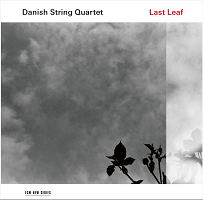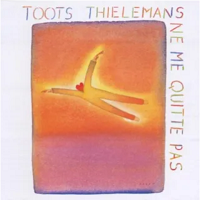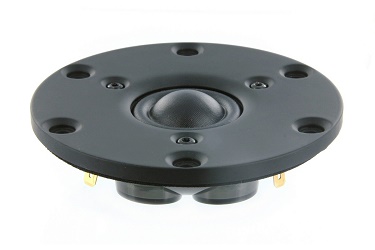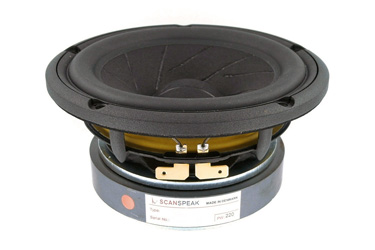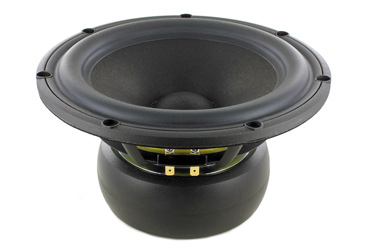ScanSpeak
Revelator-851
Copyright 2022 © Troels Gravesen
Go to on this page:
DRIVERS
CROSSOVER
CABINET
WORKSHOP PICS
MEASUREMENTS
SPEAKER-KIT
CROSSOVER LAYOUT
Beryllium dome version,
D3004/664000
Exploring new drivers can be revelatory and having spent some 50-200
hours on your newest creation you go through your record
collection and discover new things you hadn't heard before. The tonal
palette of instruments may get a new colour, maybe more true to what you
think it should be, maybe lower distortion means higher resolution and
better holographic soundstage. In the pursuit of resolution and low
distortion we have seen fancy motor (magnets) systems and we have today an
abundance of cone materials - I don't think
we ever had so many. From paper to diamonds - and everything in between.
Paper pulp never seems to go out of fashion as it can be made in all kind
of ways with additives, coatings, etc. Very rigid cones have the downside
of ringing, break-up modes, etc. They may have superior resolution but
often require steeper crossovers to eliminate the ringing. All
compromises.
The bass driver here features a hard-pressed paper cone, SD magnet
system
and high Qm, ensuring articulate and dynamic bass. The midrange with the sliced paper
cone does some of the best midrange I know of - and the tweeter has stood the test of time and has become a role model for other
manufacturers.
I have picked three drivers I really like to make a fairly small and
powerful 3-way floor-stander. It may not be revelatory - to me -
but I know all these drivers from previous constructions and client work,
and they're all just so damned good that I wanted to put them together
in a classic 3-way, thus
Revelator-851. Actually the tweeter is an Illuminator, but Revelator has
the upper hand here, so Revelator-851 it is.
The 4 Ohms Revelator 8" bass allows a decent system sensitivity
combined with a powerful bass from a modest cabinet. The 15M/8631G00,
the 8 Ohms version, is a
recent favorite doing so well in a custom design, for which it was
created, that I
just had to use it again. I never really made friends with the 4 Ohms
version, probably due to its kapton voice coil former, although I can't
be sure, but I've had clients using the 15W/4531K00
for midrange and it never worked out as I would have liked it, and it
always had to be attenuated quite a lot due to its high sensitivity. I
hardly see the point in many 4 Ohms midrange drivers
and tweeters as it costs us a lot of expensive uF for the high-pass
section of the filter, they often have to be quite attenuated - and we rarely use high-efficiency bass driver
that will justify their high sensitivity. Same goes for the abundance of 4 Ohm
tweeters with 95-97 dB sensitivity. For what? Give us old-school 8 Ohm
tweeters and we save some money in high-quality capacitors.
Any combination of drivers must be tested with
various crossover topologies to find out what works, and what doesn't. What characterises
these three drivers is their
versatility. Some drivers may do well in very specific applications, but
not have features making them first pick for any new project.
Broad-banded drivers with fairly smooth frequency response is one thing
that makes drivers versatile. This means you have room for moving points
of crossover up and down, trying various crossover topologies with
regard to slopes, etc. Speakers can be made in many ways with various
priorities based on our preferences or beliefs. There is no right. I've
heard wonderful speakers with first order crossovers and wonderful
speakers with steep 4th order crossovers. They all had something to offer the
others did not, because no speaker is perfect.
The drivers used here are easy on crossovers. Fairly linear with no serious break-up nodes that needs attention in the crossover. In particular the 15M/8631G00 is a darling, demanding as little as possible - and it is extremely linear in the midrange and upper-midrange - so vital for tonal fidelity.
Here I also wanted to give the cabinet extra attention, thus 20 mm Baltic birch
properly clad with 4 mm bitumen pads - glued with a elastic vinyl glue
to dampen panel vibration as much as possible. In addition to this a
properly braced cabinet structure.
Cabinet construction is not the easiest I've made, although you can make
the cabinet by more common measures, MDF + filler/veneers and get the most of it - or maybe
even all of it - or who knows, even more, because we never make two pairs of identical speakers
except for cabinet materials for comparison. Nobody does that. Sometimes we overdo things
because we can - and it may make us feel better,
but objectively it may not really contribute to more fidelity. Some
manufacturers makes cabinets from very thin plywood materials and
control energy absorption by adding bitumen pads and other damping
materials with the aim of pushing resonances downward away from the
midrange. This makes sense and may work very well and add certain warmth in lower
registers from smaller speakers and I have heard good examples.
Nonetheless this makes cabinets part of sound propagation and the
cabinet is resonant, no matter what we call it. The cabinet is
making sound that really wasn't meant to be there. I think thin walled
cabinets were partly a result of post-WW2 shortage of materials and was
a driver for BBC to produce good sound from what was available at the
time. Easy to handle, easy to pack, cheap on transport. Never underestimate economics in speaker manufacturing, materials'
costs, shipping weight, etc. Some manufacturers go all the way and design speakers with
extremely resonant cabinets claiming them to be like musical
instruments. To me this is far out, sorry. But rest in peace.
Basically I think cabinets should contribute as little as possible to
the sound we hear, allowing us to hear as much as possible of what the
driver is capable of - and no more.
A great deal of high-end speakers is about the story that follows -
stories we buy in to - stories meant to make us feel happy. We like to
hear about all the ingenious inventions going into a particular speaker,
often old wine on new bottles. Most commercial speakers could never
afford to use the quality of crossover components we DIY'ers can do. No
way! And they will go a long way in inventing new words and concepts in
order to persuade you buying their products. I have nothing against
commercial speaker manufacturers, absolutely not, and I have learned a
lot from listening to their products. We just have to realise what can
be put into their products given the target retail price point. An
ingenious crossover design can never be better than the quality of the
crossover components allows.
For the crossover I will use expensive components, not overkill, but
whatever it takes to enhance dynamics, transparency and
tonal fidelity as far as technology allows and within reach of at least
some people. The speaker drivers are never going to deliver better
quality than the signal they are fed.
So, three drivers I already know very well. You
may ask why am I building this speaker at all? I have made bigger
speakers, speakers that go deeper, speakers more efficient, speakers I
really, really like. Well, only solid reason I can give is curiosity. I guess every designer
has the ambition to make something good - and small. I fact I like it so
much I decided to go all in and invest is Alumen-Z for the midrange and
Amber-Z for the tweeter. Read here:
http://www.troelsgravesen.dk/Revelator-851-II.htm. Most of us live in
small homes, have fairly small living rooms, need something
reasonably unobtrusive to pass the music we love. And not least,
something that won't make your wife call for divorce. High-WAF or
low-WAF, beauty is in the eye of the beholder.
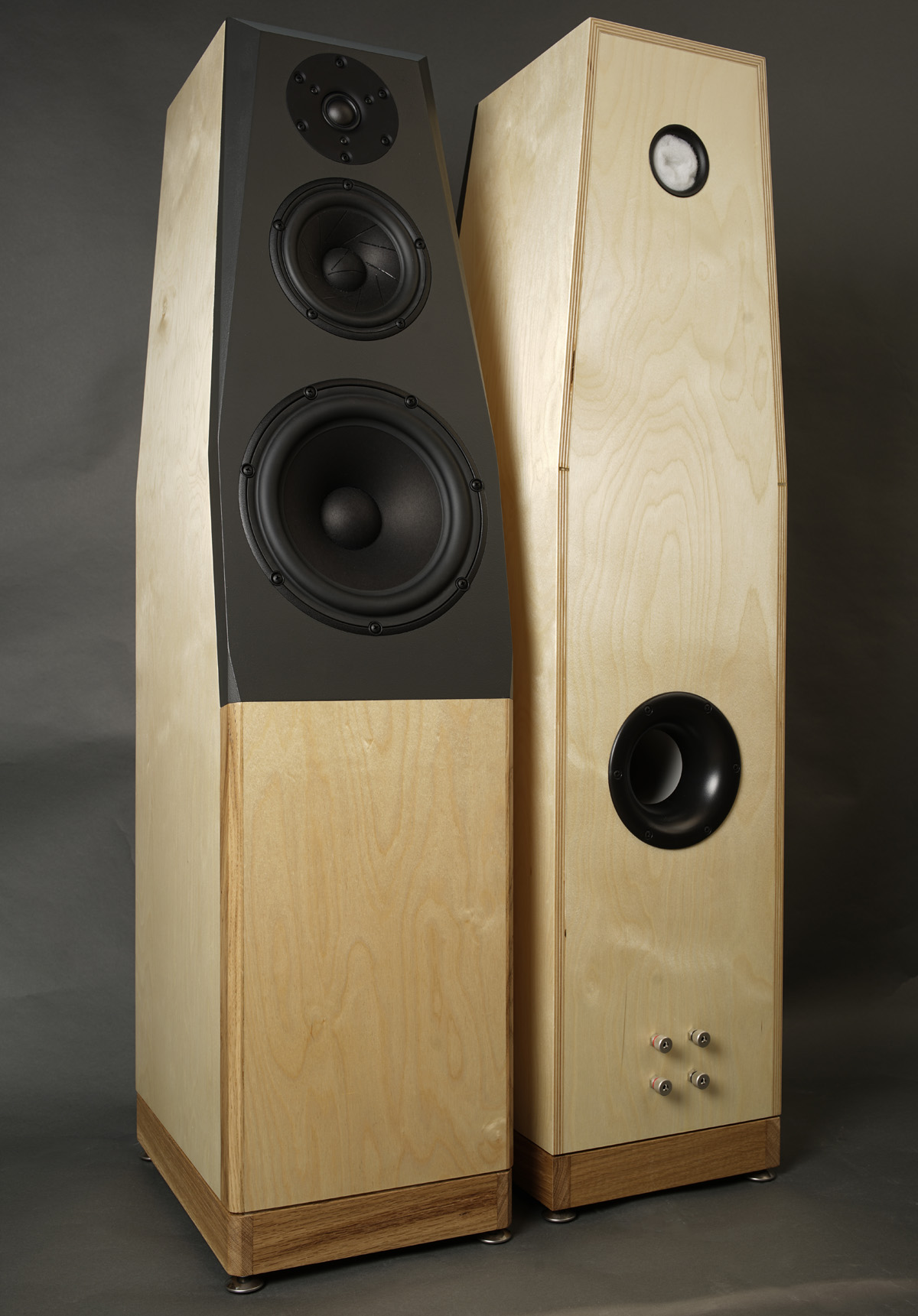
It was late evening when I sat up the finished speakers in the workshop with the test crossovers - and I wasn't quite prepared for this, because whatever I put on the turntable I had a thorough dynamic and transparent sound with a phenomenal presence that made me look into recordings in new ways - because any speaker will tell you something the former did not. That's part of the game and something not to be seduced by.

I've used the above images before to show a diverse genres of music and
the Rev-851 did them all so well I had to go the living room and pick
some 10-15 more LPs to explore further. Same results. Whatever presented
to the speakers, it all came out so well that I also had to go a pick a
bottle of Primitivo grapes to celebrate. This went on until 4 am and
maybe I got a bit sloshed, but I slept well for some 8 hours before I
took another turn with fresh ears and a mug of strong coffee. My
evening/night impressions didn't change.
This 15M/8631G00 seriously challenge the level of resolution that may
come from well engineered paper cones vs. hard cones. I honestly can't
point to any better 5" midrange driver. Period.
Danish String
Quartet, Last Leaf (great ECM release) is the litmus test for any system, from
your cartridge, your phono stage to the speakers. The Rev-851 does it.
When all is right the violin bow rosin will evaporate from your speakers
and caress your ears.
Toots Thielemans Ne Me Quitte Pas is another of my favourites
and the sharp sound of Toots' harmonica must be pointy without being
overly ear piercing. A phenomenal good live recording. It took me many
mornings - with fresh ears - tuning the midrange and tweeter to make a
proper balance.
Basics:
3-driver speaker.
Dimensions: 25 x 35 x ~107 cm, WxDxH (incl. feet).
System sensitivity: 89 dB/2.8V/1 meter.
Impedance: 4-8 Ohms.
Power requirement: 20+ watts/channel. Really depends on your room size
and how loud you play.
Power handling: 200 watts.
Please
also read:
http://www.troelsgravesen.dk/power-handling.htm,
and remember any burned driver is a misused driver.
http://www.troelsgravesen.dk/tips.htm
http://www.troelsgravesen.dk/tips.htm#CONSTRUCTION_OF_CROSSOVERS
http://www.troelsgravesen.dk/crossovers.htm
http://www.troelsgravesen.dk/LCR-RC.htm
http://www.troelsgravesen.dk/Inverted-Polarity.htm
And please also read this: http://www.troelsgravesen.dk/choices.htm
Download specs here:
D3004/660000 15M/8631G00 22W/4851T00
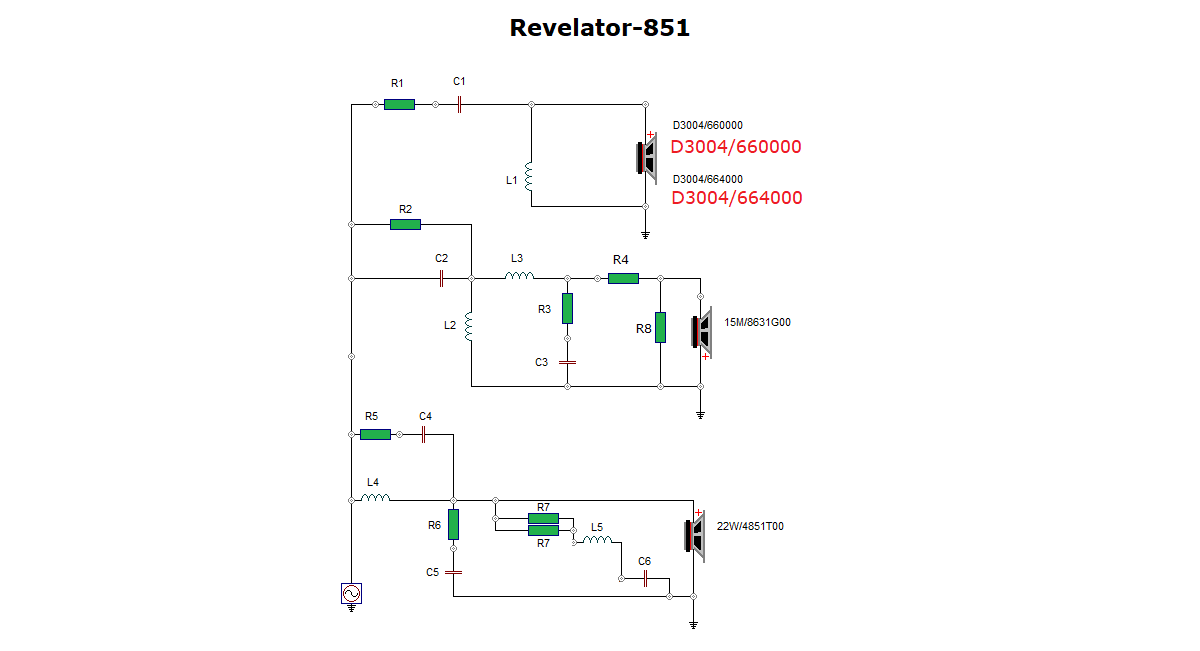
Crossover topology is the same for both tweeters, only values of R1 and
C1 varies - and varies quite a lot.
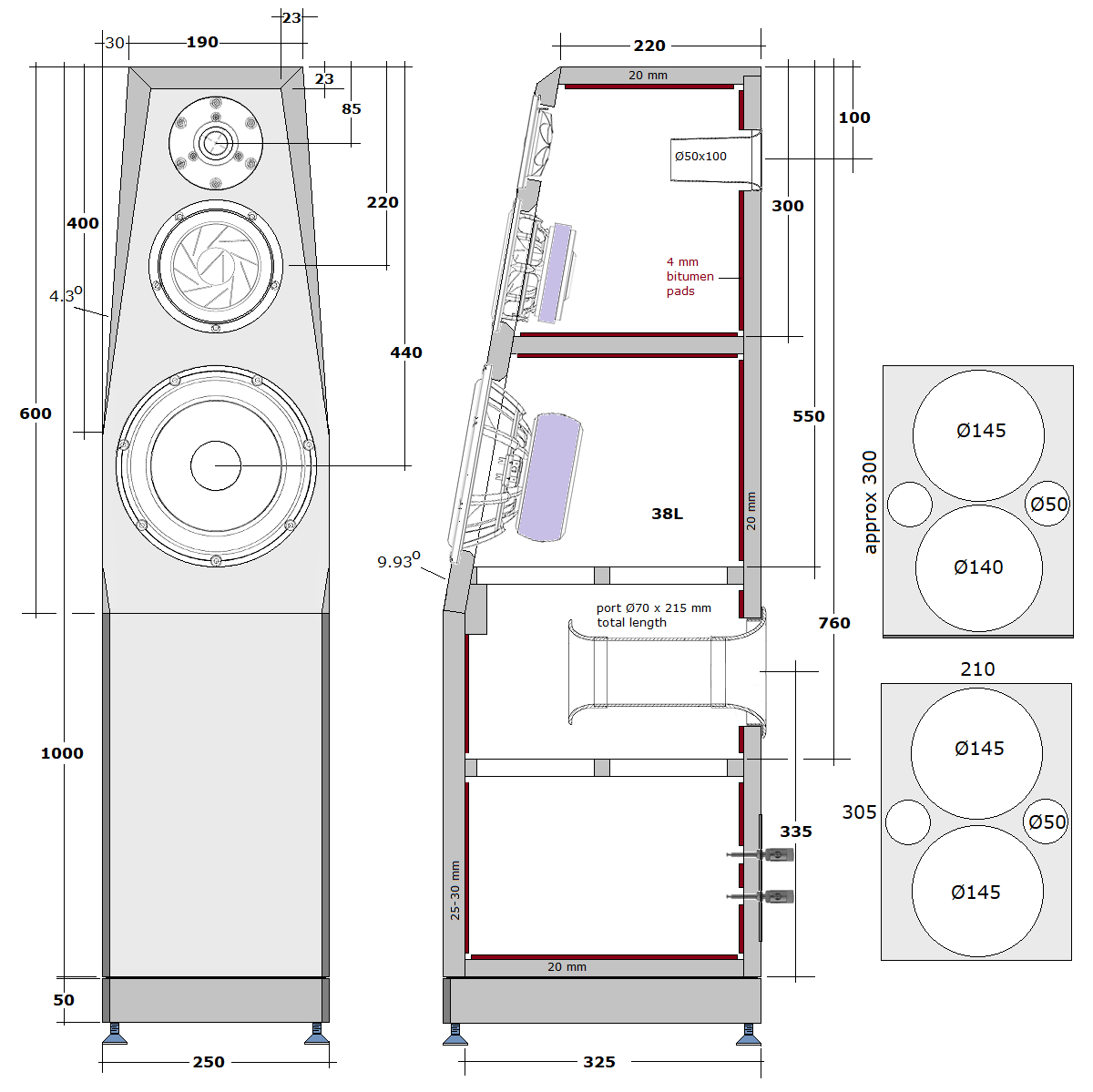
Cabinets were made from 20-21 mm Baltic birch clad with 4 mm bitumen pads.
The front panel were made from 30 mm
black MDF (HDF, Valchromat).
Faceting the front panels, look
here. Can be done by hand, a chisel and sandpaper.
Port is 215 mm total length. Cut straight port tube to 140 mm length.
The driver placements are measured parallel to the front panel, 85, 220
and 440 mm. The front panel is chamfered 45 deg., about 23 mm wide/deep.

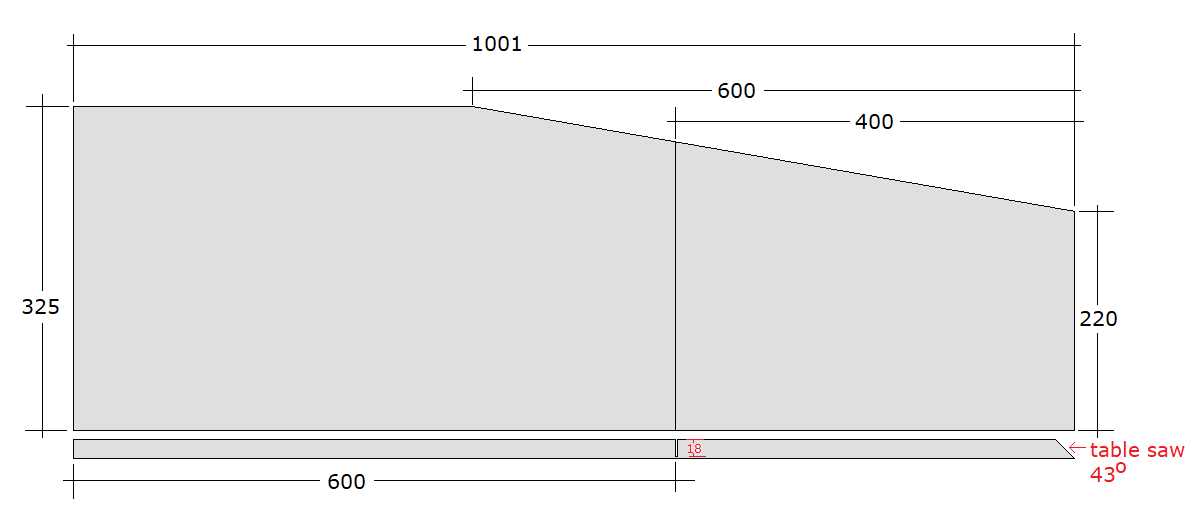
Side panels. Cut at 600 mm height to around 18-18.5 mm depth to allow
easy bending. Make tests to find the best depth.
The correct top angle is 42.86o, use 43o.
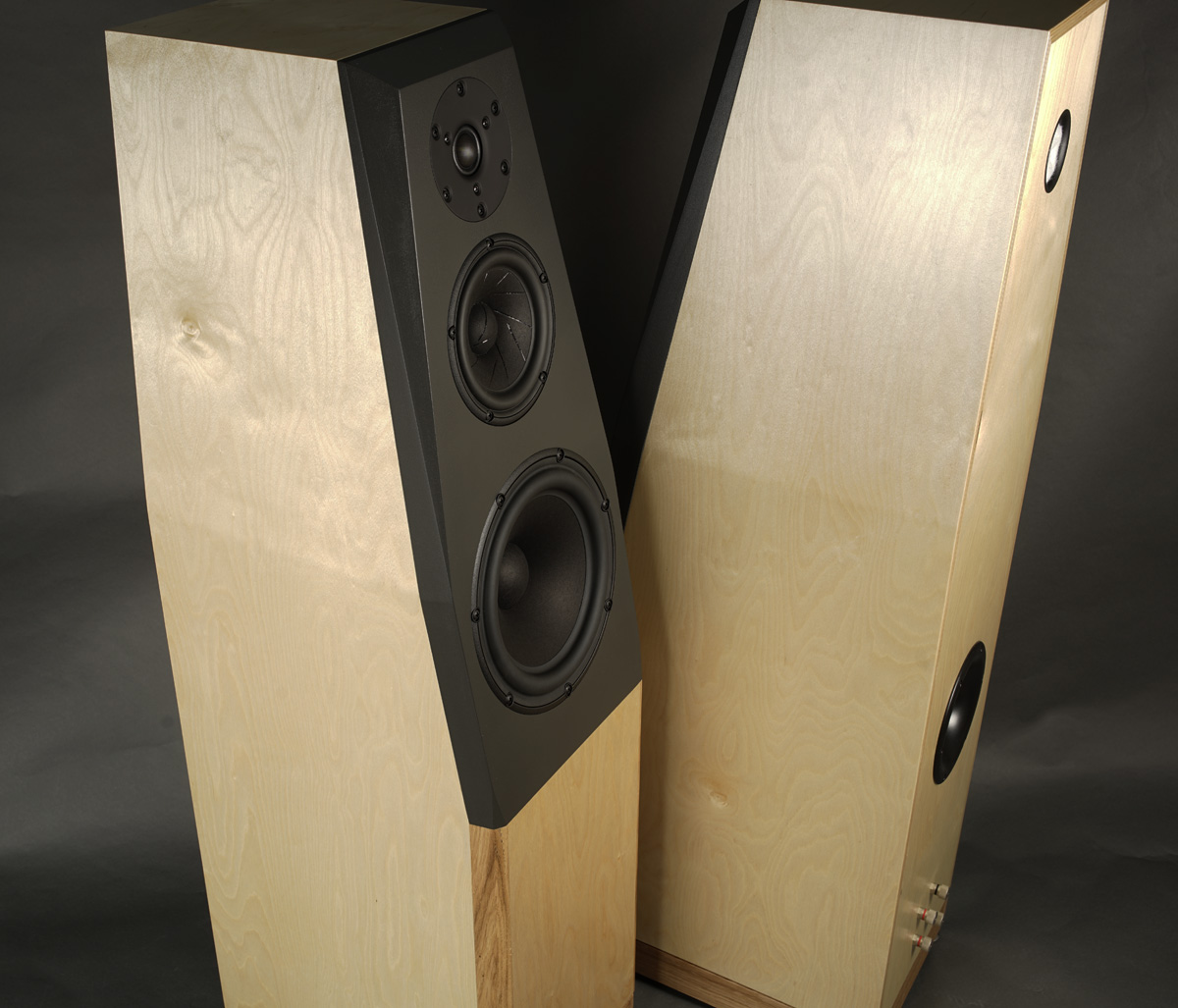


I started making the sides, top and bottom. Adjusting the rear panel is
the tricky part.
Look at
Purifi-6661 for further details. They follow the same pattern.


While making the braces the bass drivers arrived.
Beautiful engineering!


Gluing one side, rear and bottom panels - and two braces. Wait with the
midrange compartment lower panel until last.
Make absolutely sure the rear panel in perpendicular to the side if you
do it this way. Sometimes I glue it all in one step, but it's a lot of
stress as you have like 10 min. to get it all in place - and it takes a
lot of clamps, always one more than you have.
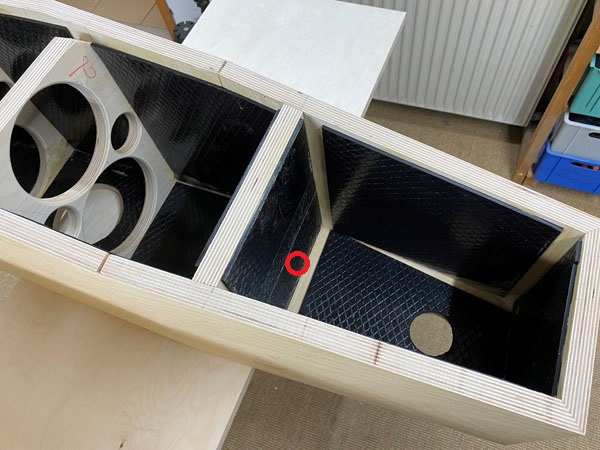
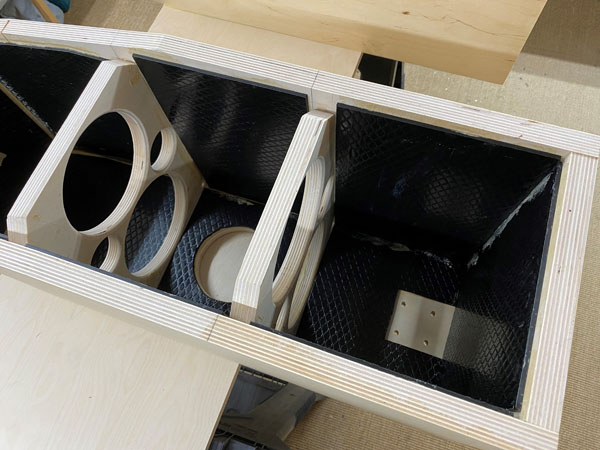
Adding bitumen pads to the interior.
Bitumen doesn't have to cover surfaces 100%. 5-10 mm to nearest boundary is fine.
Bitumen is optional and you have to add 8 pcs 50 x 50 cm to your order.
Remember to drill a 7-8 mm hole at bottom of mid-tweeter bottom panel
for the 4 wires. Red circle.
And seal the wire holes like seen
here.


Making the front panels.
Still haven't received the midrange drivers, and NEVER ROUTE BEFORE
YOU HAVE THE DRIVERS AT HAND!
All things have tolerances and the e.g. 15M is 148 mm +/- 0.37 mm.


Time for doing the felt damping and closing
off the lower part of the bass cabinet.


The rear panel behind the bass driver is left
un-damped for mounting crossover board.
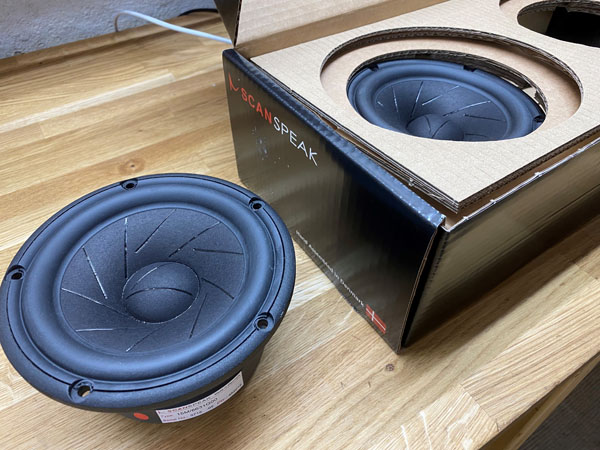
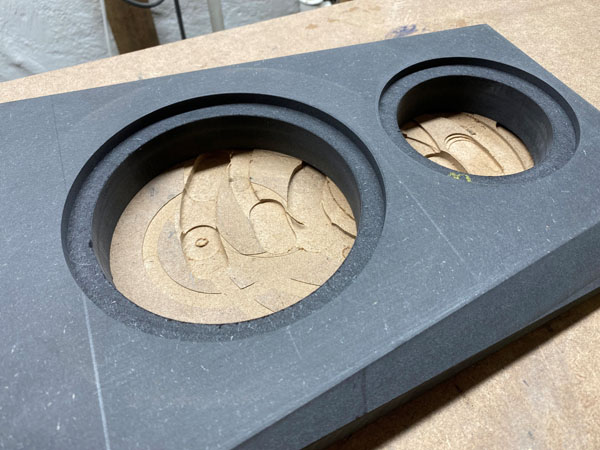
Finally the 15Ms arrived. Time to do the
midrange routing.
I use 30 mm for the front panels and it makes a deep hole for the
driver.
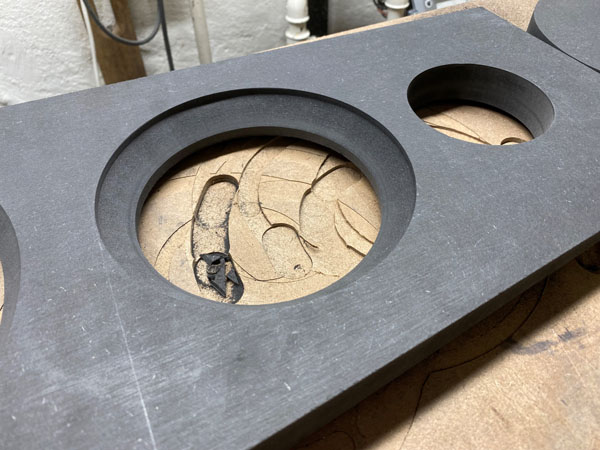
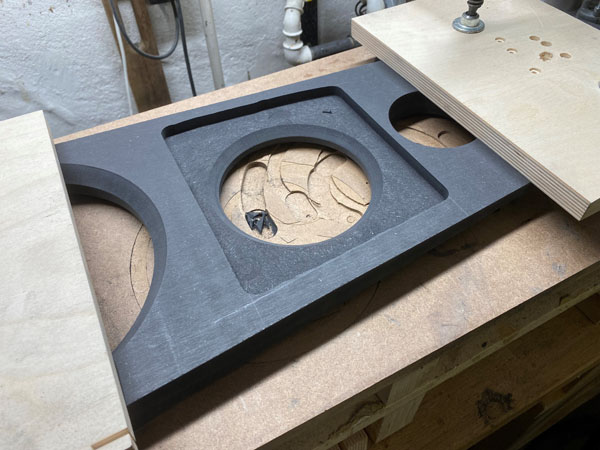
In order to have the driver breathing chamfer
driver hole as seen on images and further remove some 10 mm around the
hole.
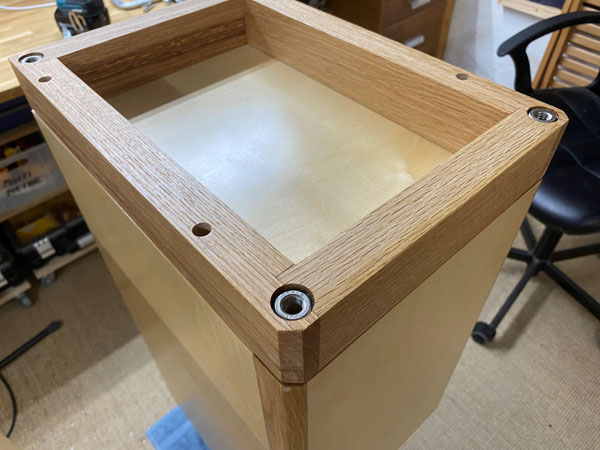
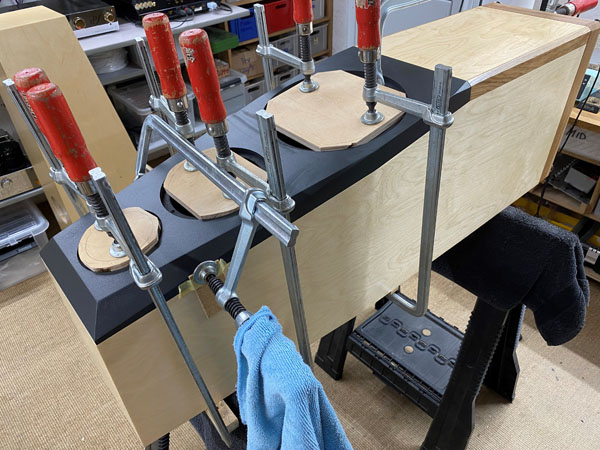
Left: The 50 mm base support, where the
mid-tweeter crossover is going to be placed.
Right: Gluing front panel.
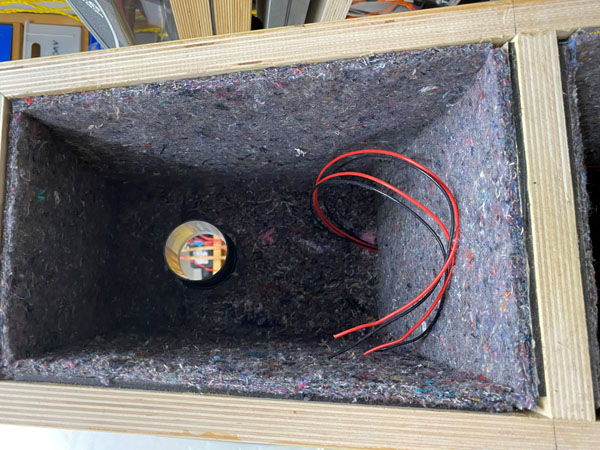
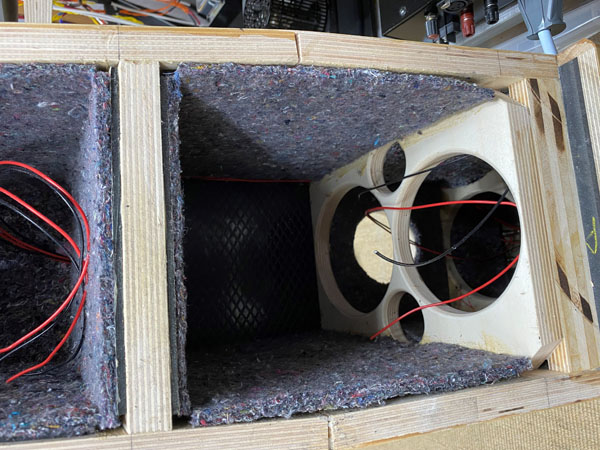
Mid-tweeter and bass compartments. Make sure
cable holes are sealed!
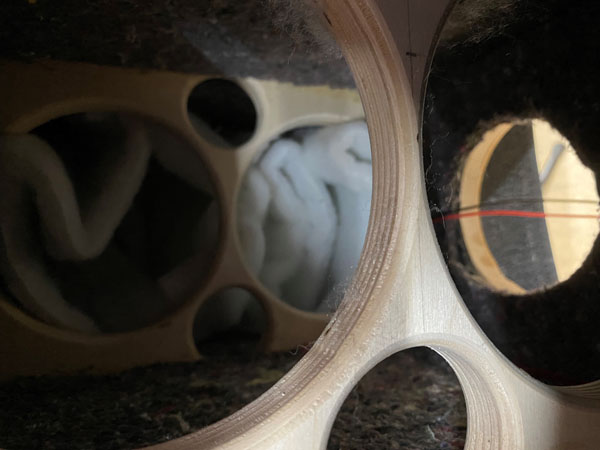
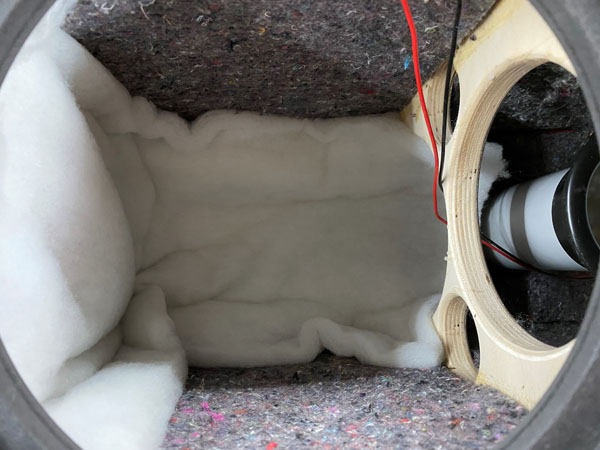
Left: Stuff bottom section with 2 pcs 50 x 50
cm acoustilux.
Right: Place a folded piece of 25 x 50 cm behind bass driver - on top of
bass crossover.
Add one piece of 25 x 50 cm acoustilux on top above bass driver and
another layer on top of crossover.
Add 150 grams sheeps wool on midrange cabinet.
Roll a piece of 80 x 350 mm acoustilux and stuff the midrange port.
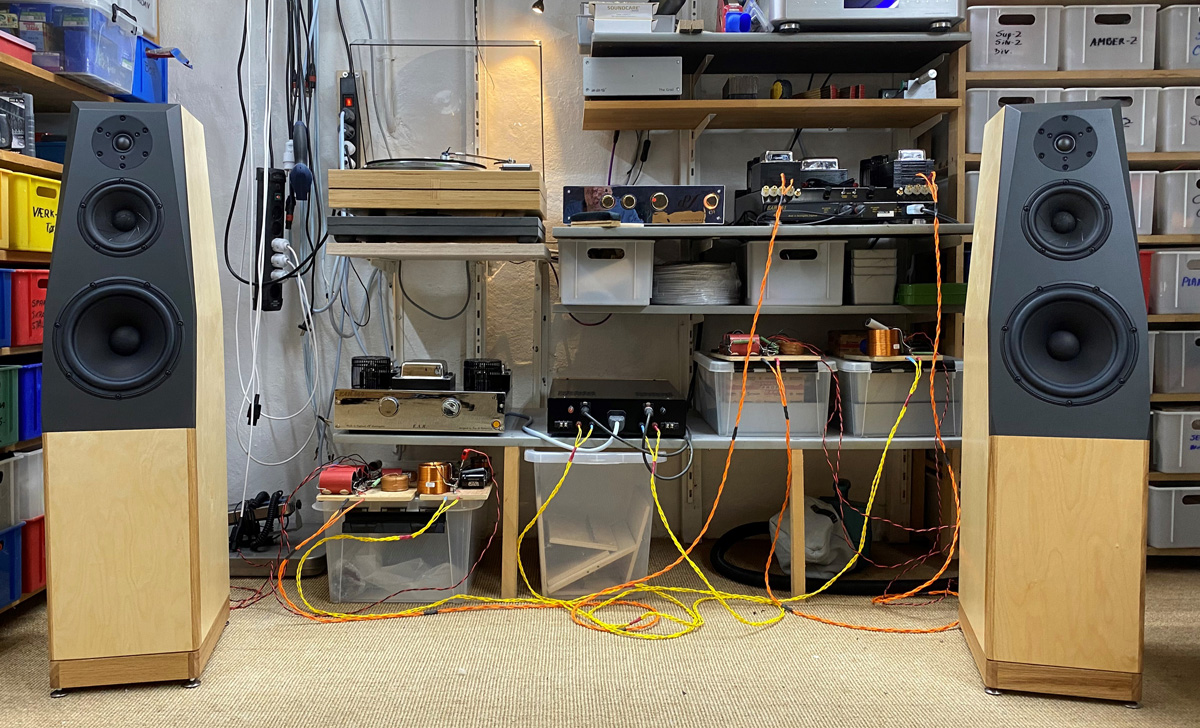
First time workshop setup - with prototype
crossovers. I used my Hypex UcD for bi-amping.
A few comments on
MEASUREMENTS before you start interpreting the readings below.
First of all, if we think measurements will
tell us how a speaker sounds, we're wrong. The perception of sound is
way too subjective to be reflected in any measurements we can perform. A
loudspeaker system is meant to give us a satisfying idea of an acoustic
event and for some people a pair of 5 USD ear-plugs are enough, others
spend 200 kUSD on a truly full-range pair of speakers - and the latter
may not be happier than the former.
Measurements may give us an idea of tonal balance of a system, i.e. too
much or too little energy in certain areas, although dispersion
characteristics play a vital role here. A two-way 7+1 and a three-way
7+4+1 may display similar horizontal dispersion, yet sound very
different. Measurements may tell us about bass extension if far-field
measurements are merged with near-field measurements. In addition to
this, ports may contribute to bass extension. Most of we diy'ers do not
have access to an anechoic room for full-range measurements from
20-20000 Hz.
What cannot be seen is what kind of bass performance we get in a given
room. Bass performance is highly dependent on in-room placement of your
speaker and the same speaker can be boomy in one place and lean in
another. Actual SPL level at 1 meter distance and 2.8V input is useful
for en estimate of system sensitivity and combined with the impedance
profile may give an idea of how powerful an amplifier is needed to drive
the speaker to adequate levels.
What measurements do not tell is the very sound of the speaker unless
displaying serious linear distortion. The level of transparency, the
ability to resolve micro-details, the "speed" of the bass, etc., cannot
be derived from these data. Distortion measurements rarely tell much
unless seriously bad, and most modern drivers display low distortion
within their specified operating range.
Many people put way too much into these graphs and my comments here are
only meant as warning against over-interpretation. There are more to
good sound than what can be extracted from a few graphs. Every graph
needs interpretation in terms of what it means sonically and how it
impacts our choice of mating drivers, cabinet and crossover design.
What measurements certainly do not tell is the sonic signature of the
speaker, because speaker cones made from polypropylene, aluminum,
Kevlar, paper, glass fiber, carbon fiber, magnesium, ceramics or even
diamonds all have their way of adding spices to the stew. Nor do
measurements tell what impact the quality of the crossover components
add to the sound, from state of the art components to the cheapest of
coils and caps, they all measure the same if values are correct, yet
sound very different.
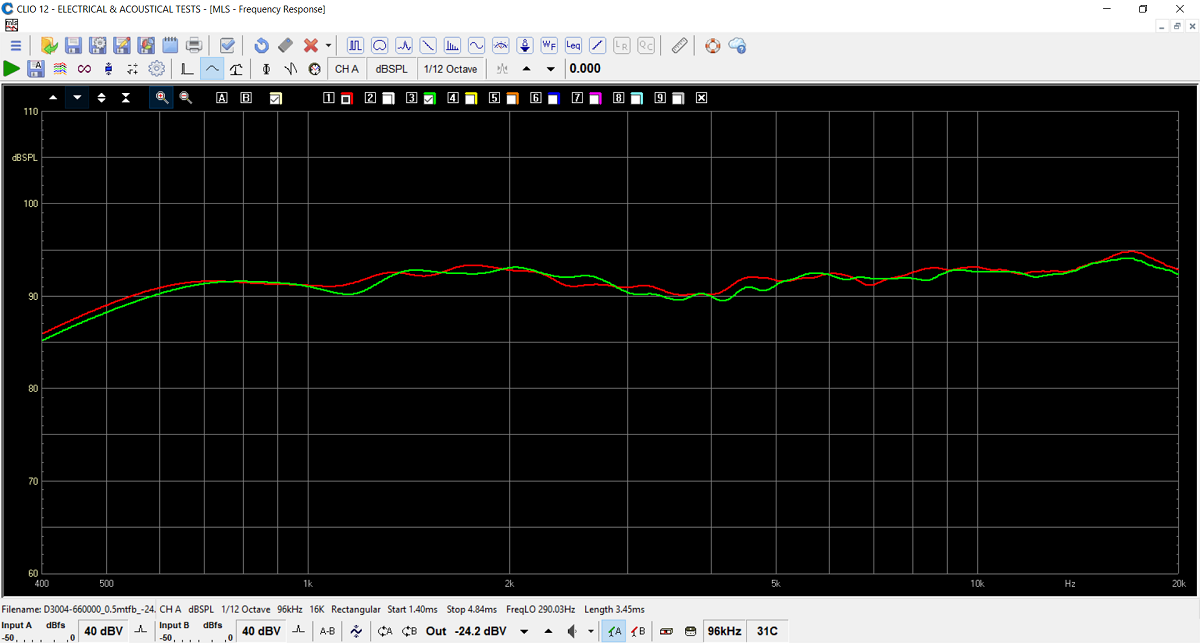
Tweeter D3004/660000 on actual baffle at 0.25
(red) and 0.5 (green) meter distance.
Almost as linear as on an infinite baffle and
distortion is low to down below 700 Hz.
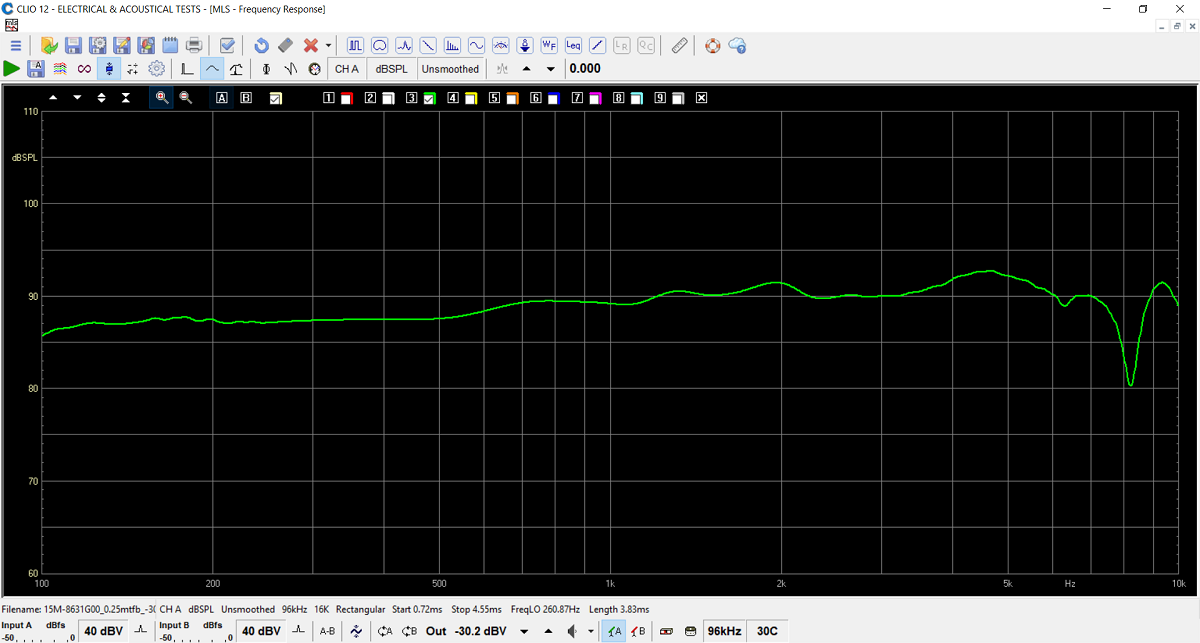
Here the 15M/8631G00 on actual baffle.
I couldn't be more pleased.
Extremely broad-banded up to around 7 kHz. And no rubber disturbances
around 1 kHz.
I guess this is one reason I like this speaker so much. Having a
midrange driver doing the above, calls for simple straight forward
crossovers with no notch filters or equalising circuits.

Response of 22W/4851T00 on actual baffle,
merged with near-field response @ 175 Hz.
Sensitivity ~90 dB.
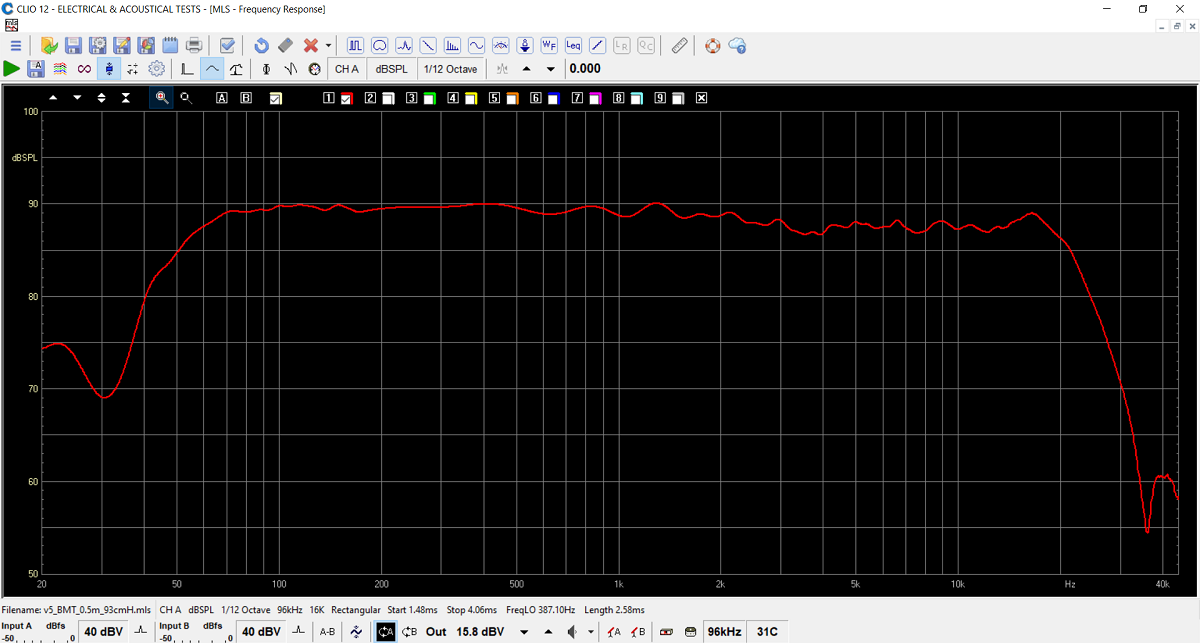
Final SPL normalised for 2.8V/1 meter. Merged with nearfield response @
175 Hz.
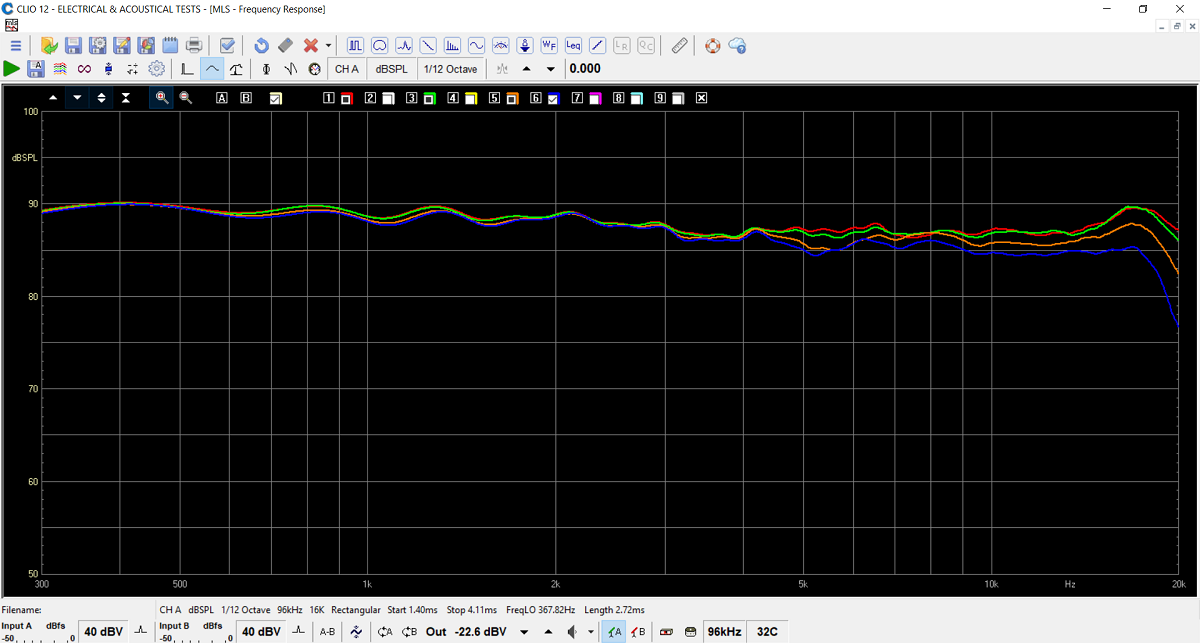
Horizontal dispersion @ 0, 10, 20 and 30 deg. off-axis.
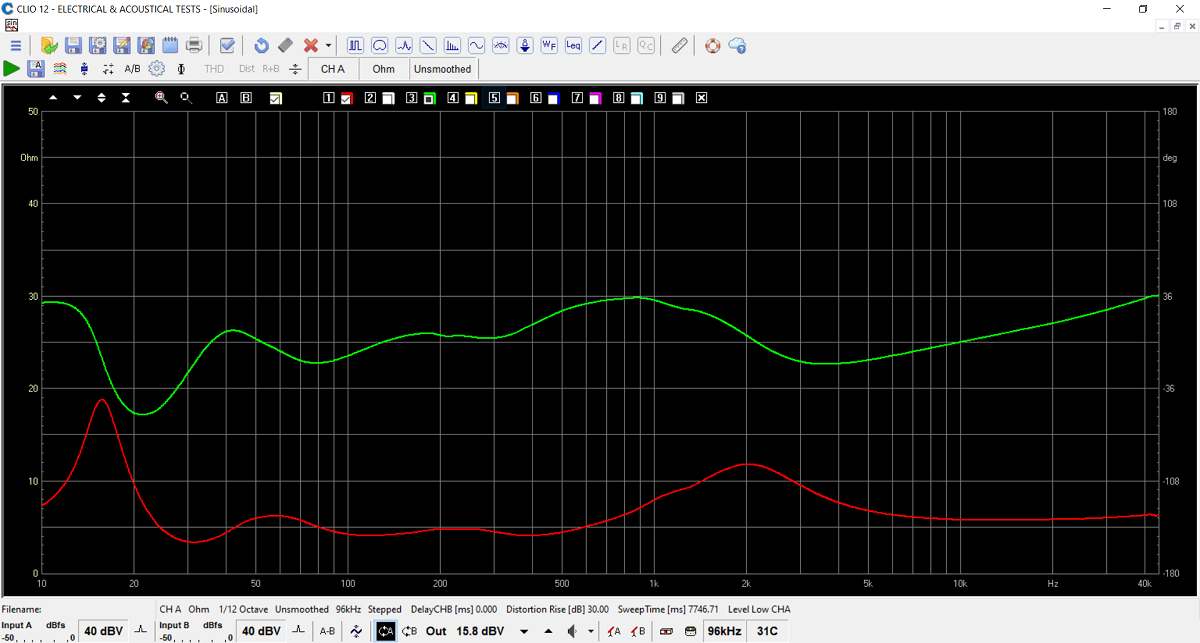
Final system impedance. Minimum 3.3 Ohms at 31 Hz (port tuning).
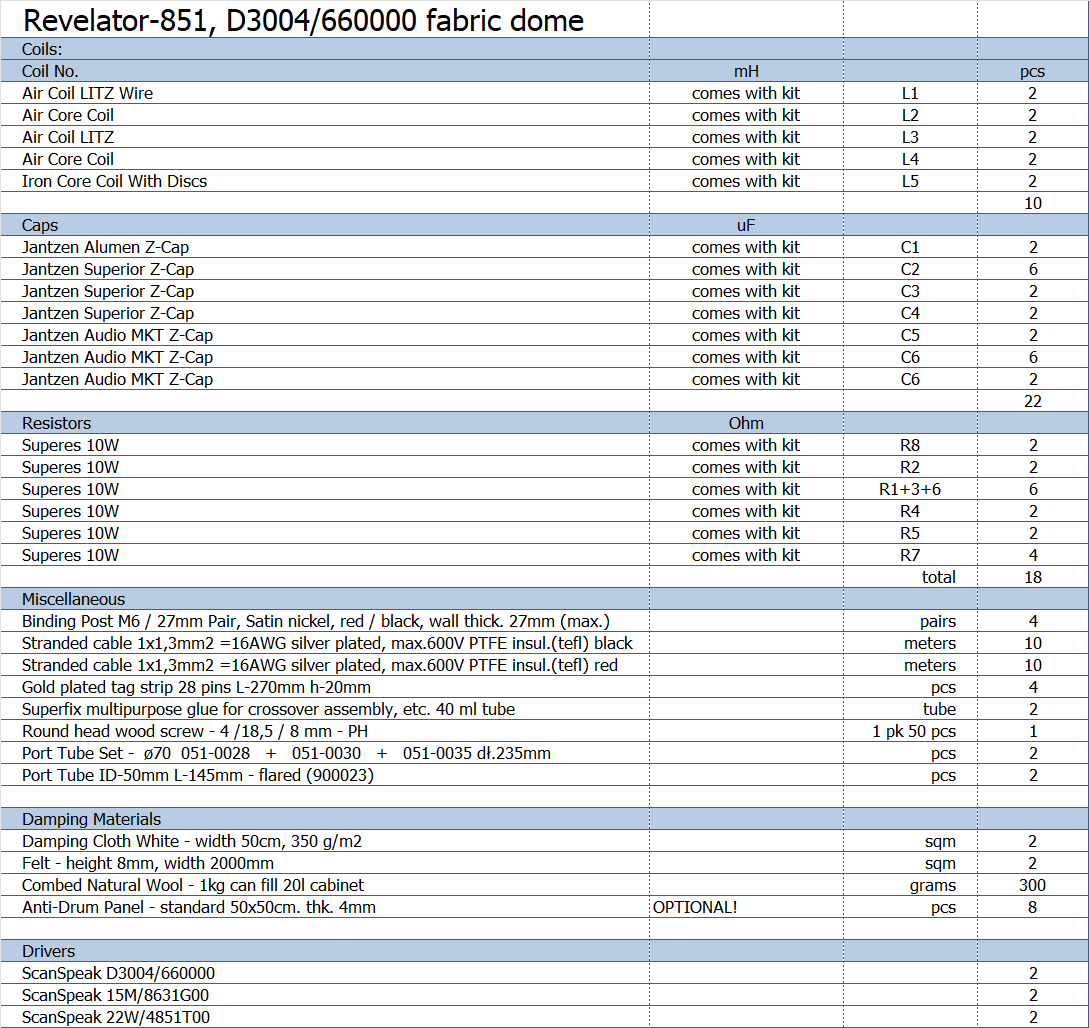
Pay notice the bitumen pads - due to weight - are optional.
I strongly recommend using them, but may be cheaper to buy locally - if
you can get them.
All kit and component prices may be subject to change and are always to be confirmed by Jantzen Audio Denmark.
Kits can always be bought with/without drivers, or some of the drivers.
Download Complete Kit Sale Presentations:
All technical questions to troels.gravesen@hotmail.com
All questions regarding purchase of kits, please mail Jantzen Audio at contact@jantzen-audio.com
CROSSOVER-LAYOUT
BACK TO INDEX
Check this out before start making crossovers:
http://www.troelsgravesen.dk/tips.htm#CONSTRUCTION_OF_CROSSOVERS
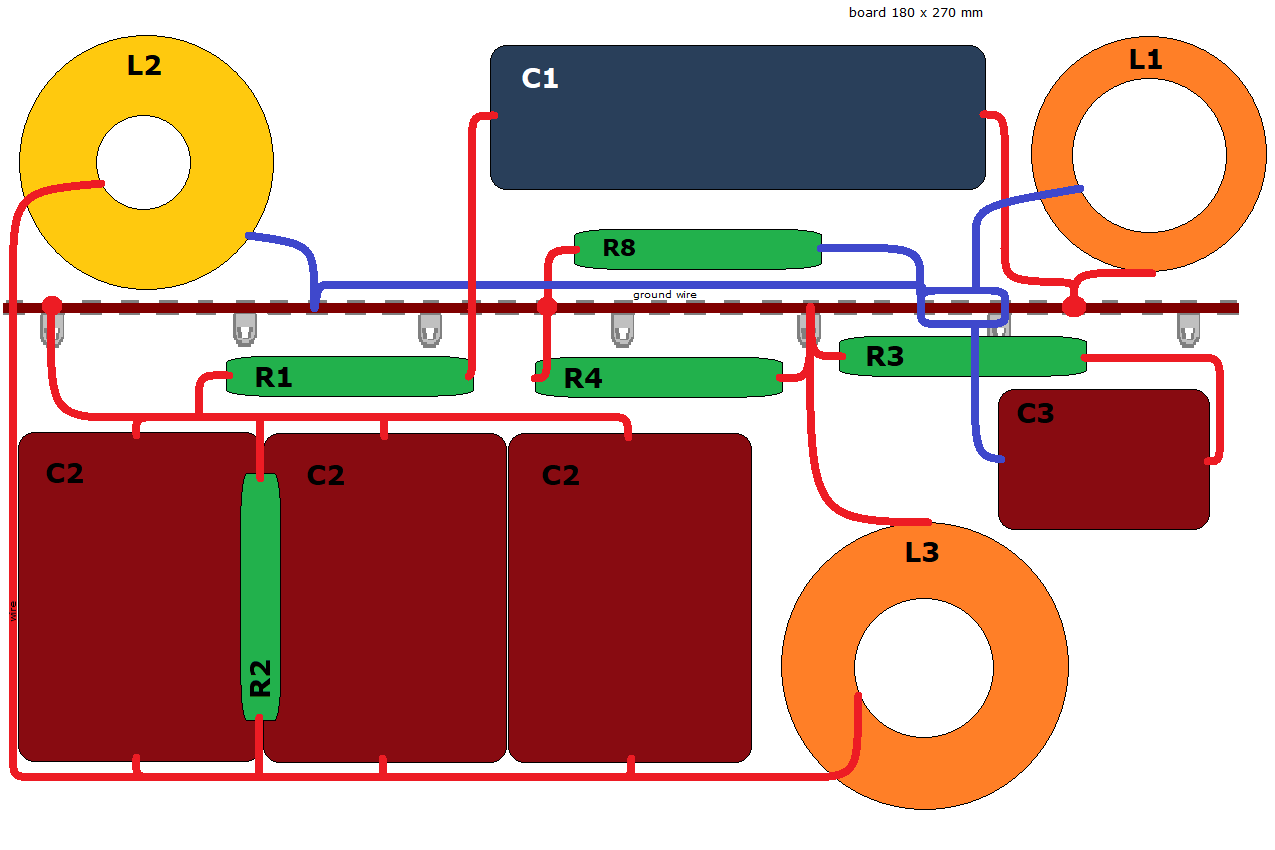
Mid-tweeter crossover layout.
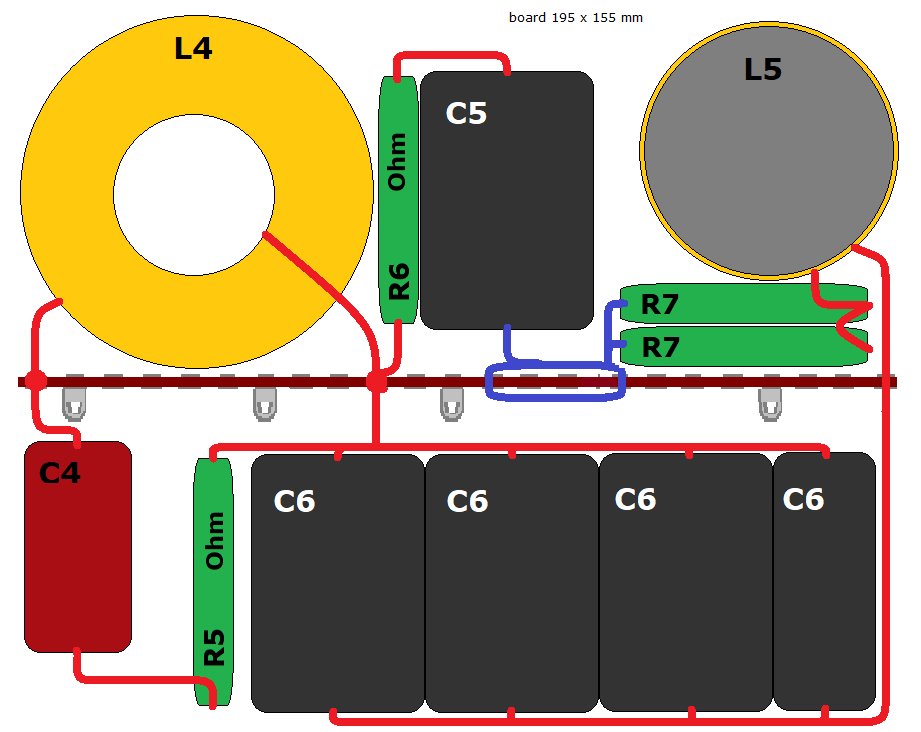
Bass crossover layout with updated MKT caps.
Speaker wiring:

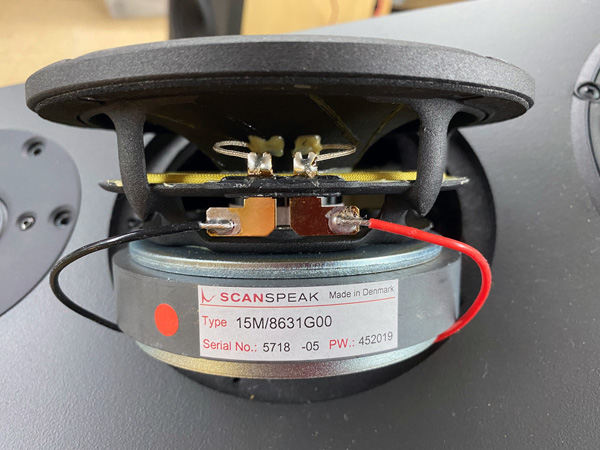
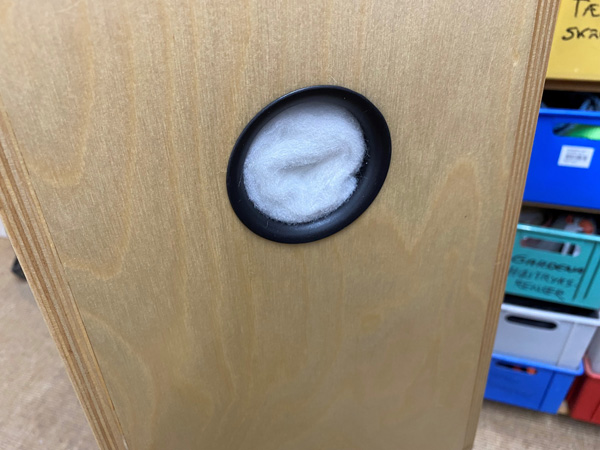
Remember to wire the midrange with inverted
polarity. This can be done either at driver terminals or on the
crossover. Here black wire going to driver PLUS.
Stuff the midrange port with a role of acoustilux, 8 x 35 cm.
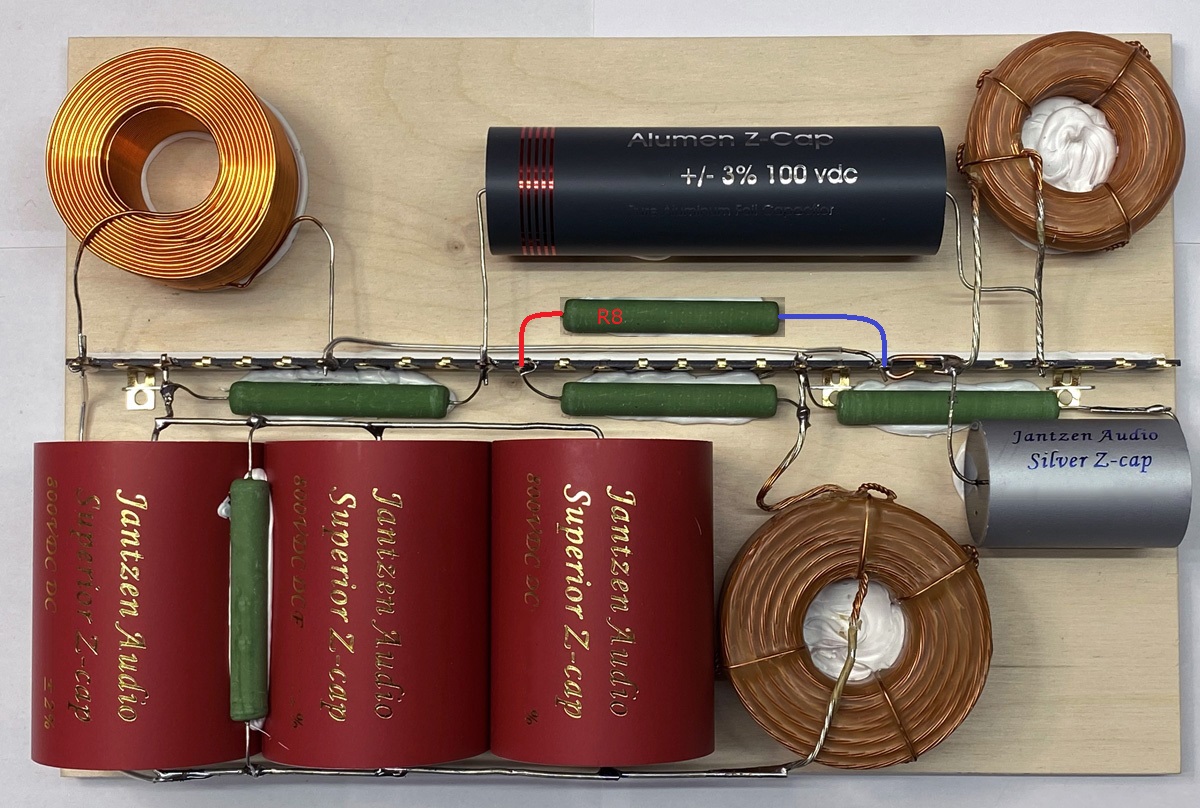
R8 was added after the photoshoot.
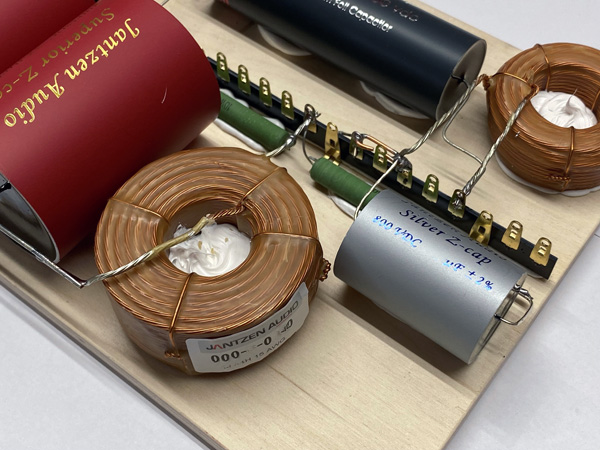
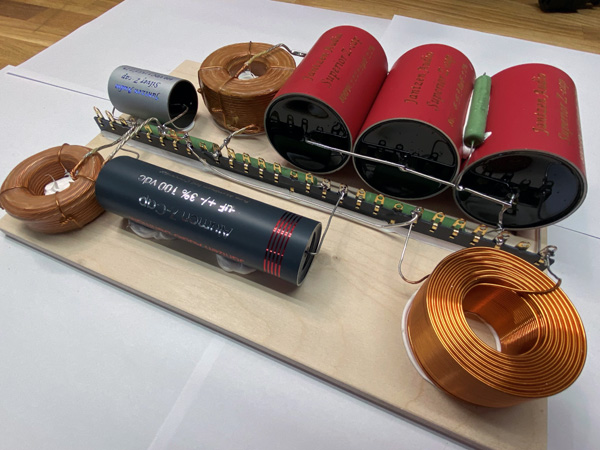
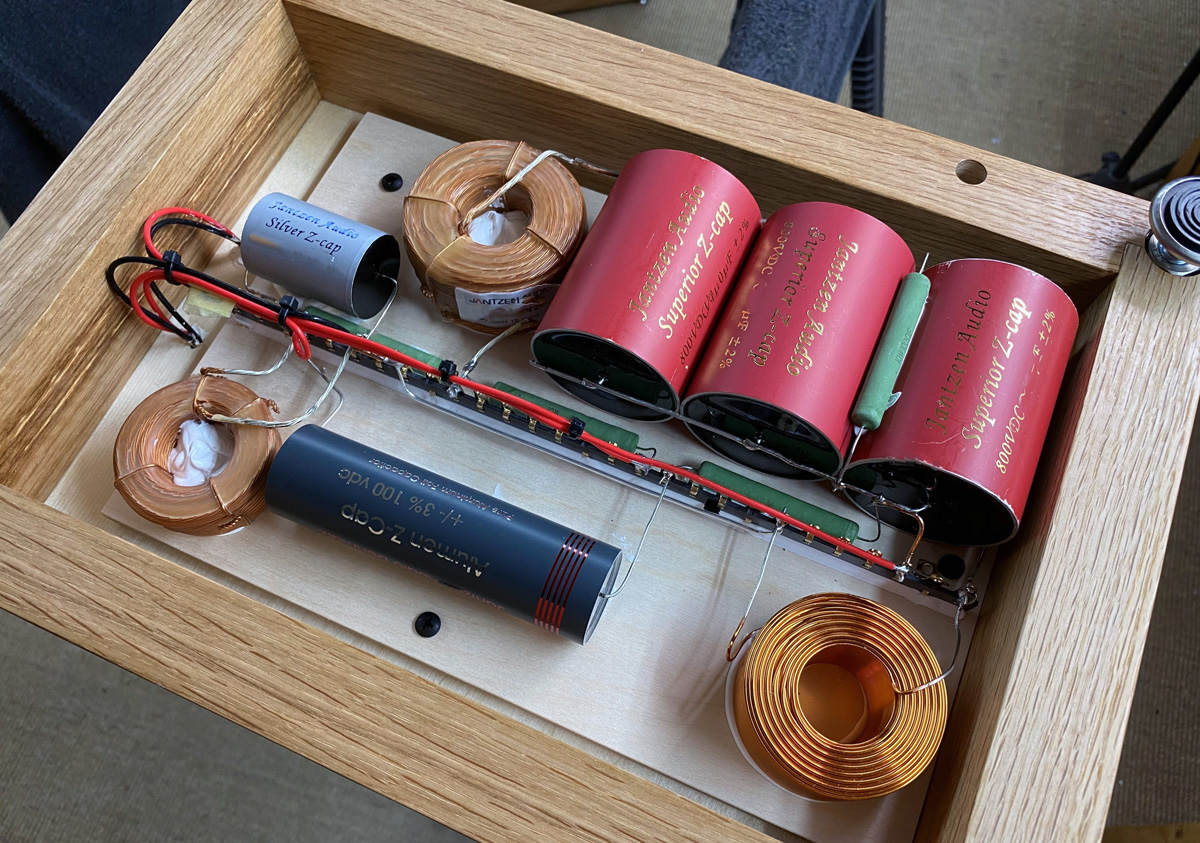
MT section neatly placed at bottom and with
good space between coils.
The cored coils are really heavy and should you ever consider shipping
your speakers, I suggest this:
http://www.troelsgravesen.dk/tips.htm#HEAVY_CORED_COILS

Bass crossover placed on rear panel behind 22W driver.
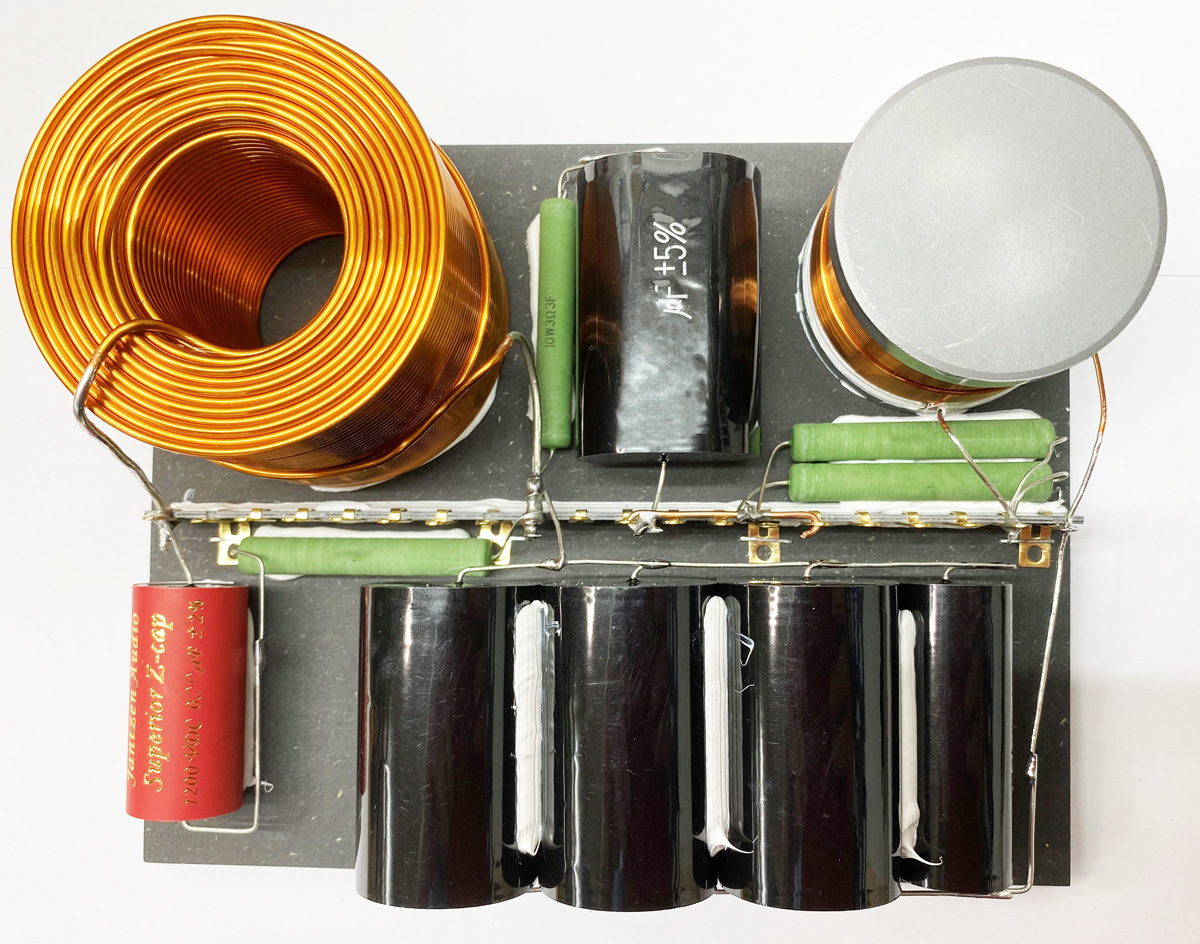
Here the final bass crossover with the new
MKT caps.


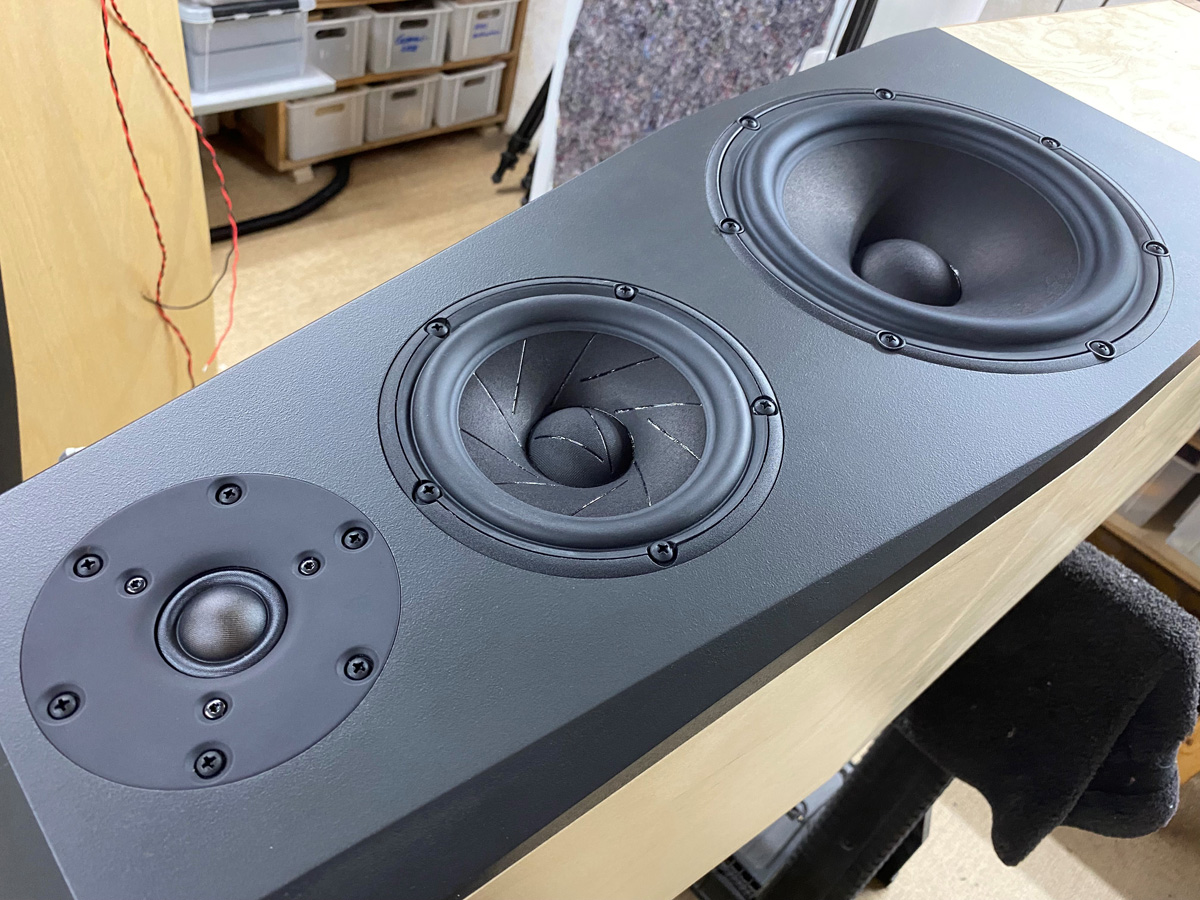
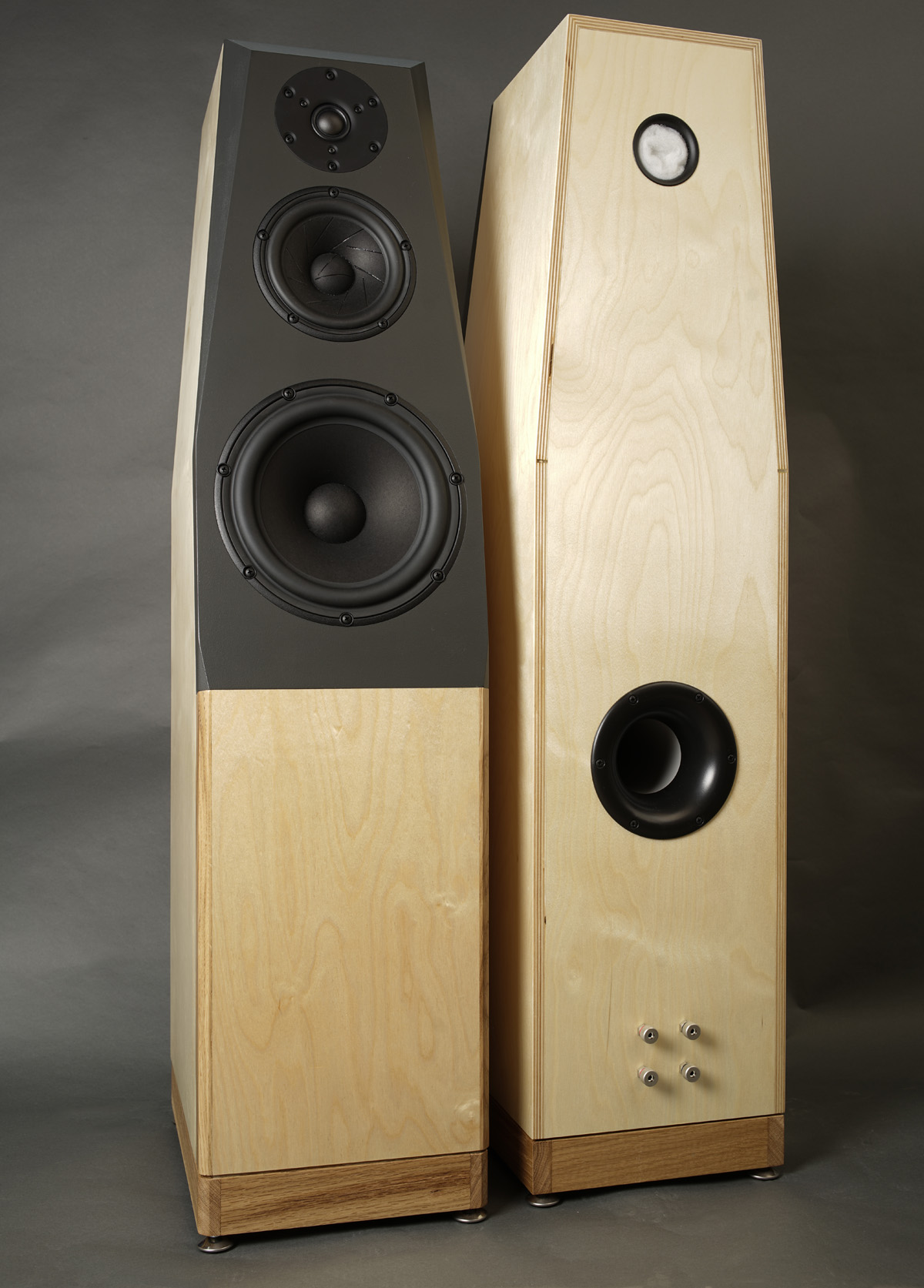
Beryllium dome
version, D3004/664000
There have been requests for version of this
speaker with the D3004/664000 Beryllium dome. I've been hesitant
because the fabric 6600 dome works so well. There is by some
builders an obsession with Be domes and well, if it makes you happy,
then I won't be in the way.
Fortunately the 6640 dome fits into the front baffle without any
modifications. Only the crossover took quite some time as the
frequency response of the 6600 and the 6640 domes is quite
different. Eventually only R1 and C1 must be changed and this won't
make exactly the same frequency response, but still within +/- 0.5
dB of the fabric dome and this was where I wanted it to be, not
changing the overall voicing of the speaker. So, the Be dome won't
sound exactly the same, but very, very close - and I
certainly like what I hear.
Does the Be dome sound better? I really can't tell, because it's so
close it's a matter of taste. The 6640 may be a tad more clean,
where the 6600 is a tad more lush with an overall very harmonic
overtone structure. And when I write tad- I mean tad.
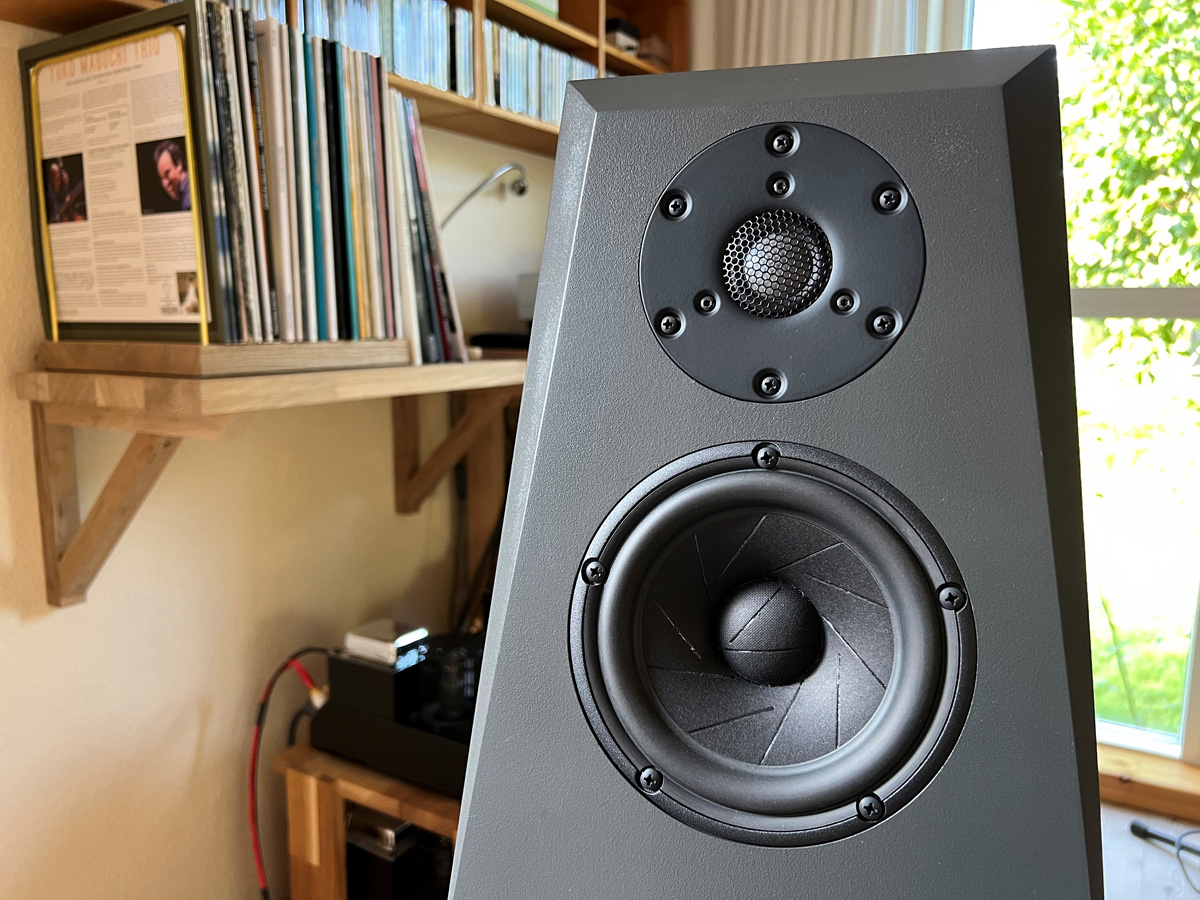
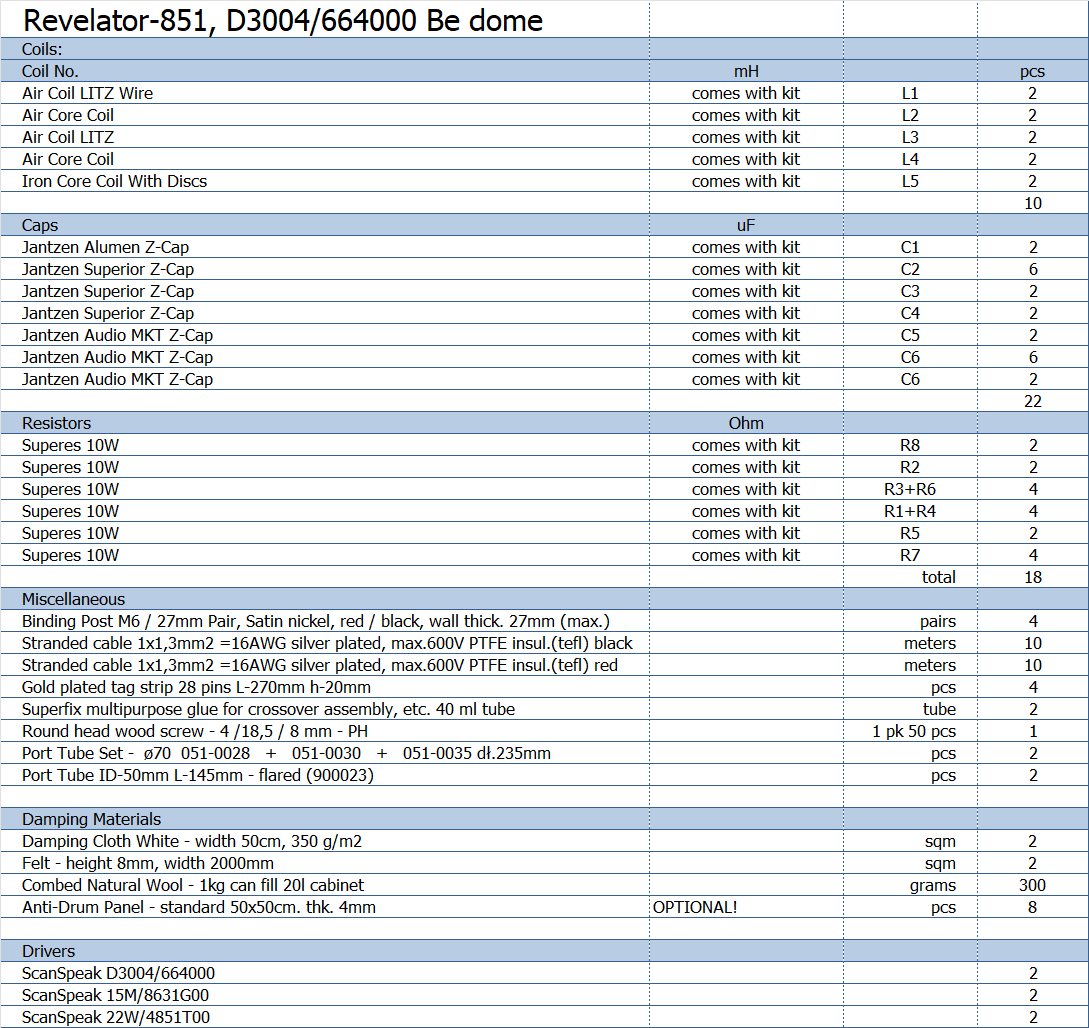
Parts list for Be dome version. Only R1
and C1 varies from fabric dome.
Crossover layout is the same. See above.
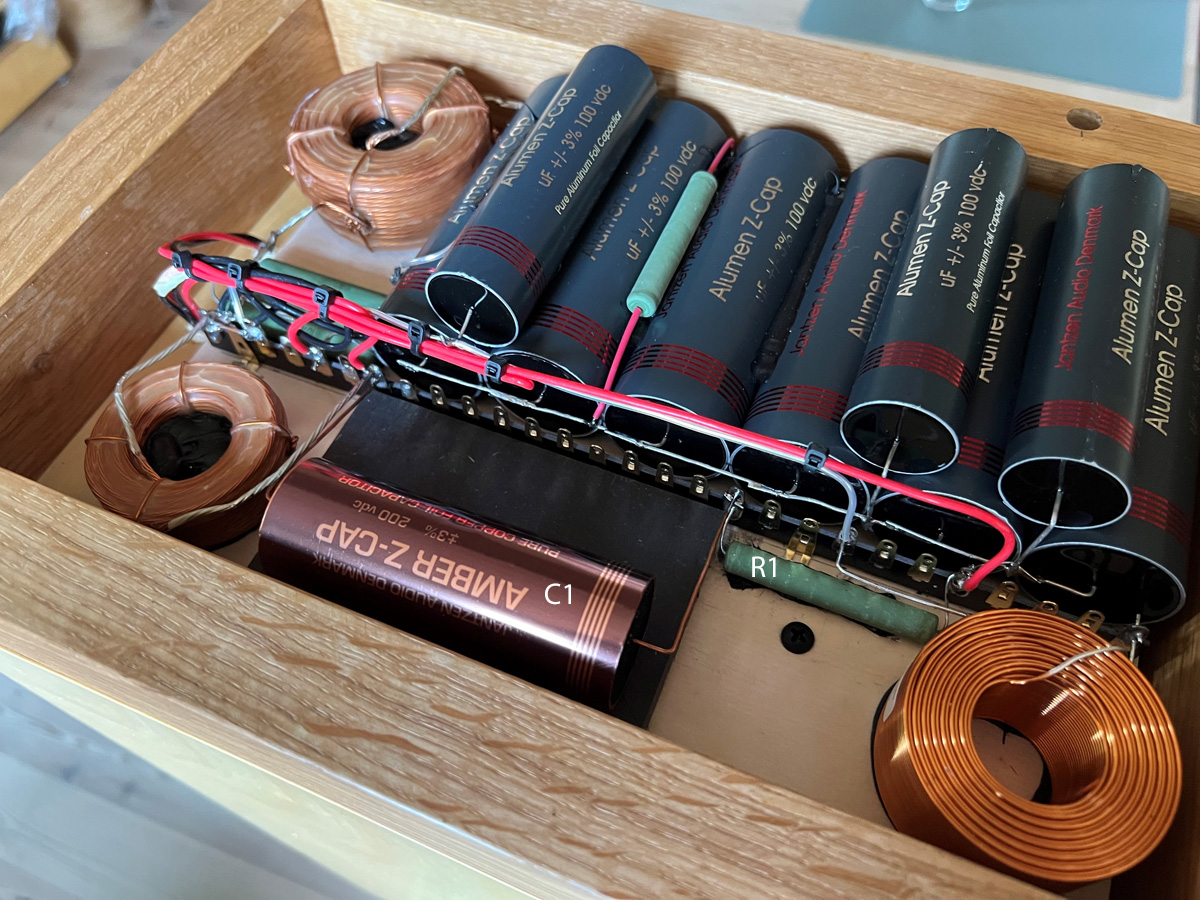
Above my insane luxury version with
Alumen-Z for midrange and Amber-Z for tweeter.
